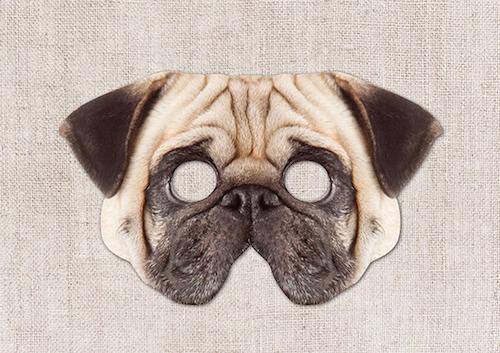
Pugs come in several colors, but only two are acceptable in a conformation ring by the AKC, fawn and black. Meanwhile, both the FCI and United Kennel Club include silver and apricot, as well as the fawn and black, as acceptable colors. All of them have some degree of a mask, the more intense and well defined it is, the better, and even black dogs have masks, though for obvious reasons, they are harder to detect. While we’re on the subject of Pug masks, we thought you might be interesting in having your own:

We couldn’t resist. We found this printable mask sold by RandiPrintables on Etsy
Black is said to be the second most common color in the Pug even though it is the dominant color, and according to one source, about 2/3 of Pugs are fawn colored, or in the fawn range (the gene that controls this difference is “K”). We can’t authenticate the scientific nature of a survey taken of 2,693 Pug dog owners from 27 countries, but 65% of those who responded said their Pug was fawn, 22% were said to be black, and from there, 4%, were apricot, 3% were silver-fawn, and 1% were brindle, a color in the breed we’ll discuss another time.
When the topic is dogs and color, it’s easy for us to get side-tracked on the way to the point we wanted to make from the beginning, and that point has to do with something called, “trace.” The word appears in the breed’s AKC standard: “The trace is a black line extending from the occiput to the tail.” The “line” isn’t a line as drawn with a ruler, but appears as darker hairs extending down the back of a fawn Pug as it appears in the picture at the top. And now you know.
